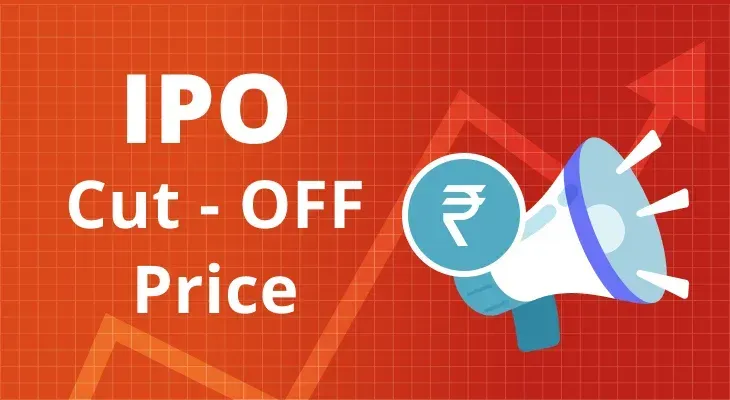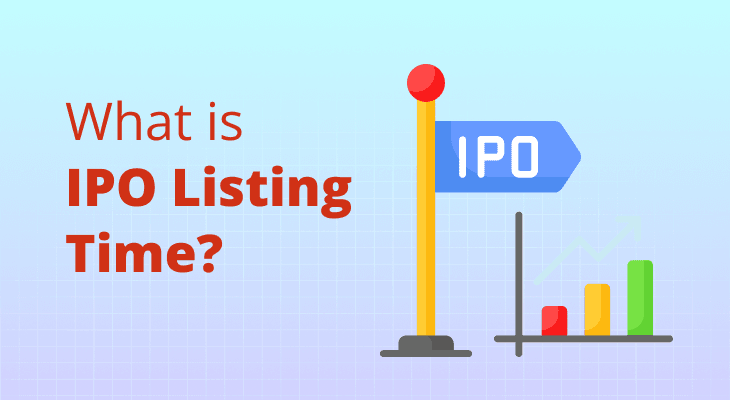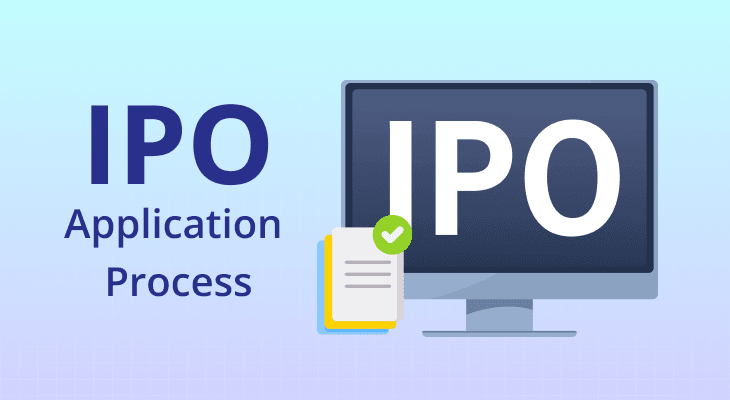
Table of content
- Importance of Cut-off price in IPO
- Types of IPO Pricing in India
- Selecting Cut-off price while applying
- Why Select the Cut-off Price?
- Considerations When Selecting the Cut-off Price
- Role of Cut-Off price in IPO
- Factors Affecting Cut-Off Prices in IPOs
- Calculation of Cut-Off Price
- Formula for Calculating Cut-Off Price
- Example of Cut-Off Price Calculation
- How to improve chances of getting an IPO allotment?
What is Cut-Off Price in an IPO?
If you are planning to apply for an IPO, you need to know the key terms and phrases associated with an Initial Public Offering. One such term is cut-off price. The meaning of the cut-off price is quite simple — it is the price at which shares are allotted to you after you have applied for an IPO successfully. Once the bids for an IPO have been received between the opening and closing dates of the offering, the company calculates the IPO cut-off price based on the bid prices. This price is typically within the price band set for the IPO. According to SEBI’s guidelines, retail investors have the option to apply for an IPO at the cut-off price itself. Furthermore, each investor has the option to bid up to three times for an IPO.
Importance of Cut-off price in IPO
When investing in an Initial Public Offering (IPO), one term that often comes up is the "cut-off price." This concept is crucial for investors wanting to participate in an IPO and can significantly influence your investment decision. Here, we break down why cut off price in an IPO is important.
Ensures Fair Allocation
The cut-off price in IPO mechanism helps in fair allocation of shares among all the investors who are willing to pay the highest price for the shares. This is particularly important in highly sought-after IPOs, where the demand can exceed the number of shares available.
Maximises Chances Of Allotment
By opting for the cut-off price, investors can increase their chances of getting share allotments. It signals to the company and underwriters that the investor is flexible with the pricing within the upper price band.
Reflects Market Sentiment
The cut-off price in an IPO often reflects the market sentiment towards the new issue. A high cut-off price indicates strong investor interest and confidence in the company’s potential.
Determines Final Issue Price
The cut-off price is crucial as it directly influences the final issue price of the IPO. The final issue price is typically set around or at the cut-off price if the IPO is well-received.
Types of IPO Pricing in India
IPO pricing in India is done in one of two ways - Fixed Price mechanism and Book Building method.
Fixed Price Mechanism
As the name indicates, the price of the shares is fixed in this type of IPO pricing. The demand for the company’s shares is not known till the issue date, which is when the company reveals the information about the demand from different categories of investors. However, the share price is fixed by the company beforehand, so you don’t have to bid at different prices for the shares being issued.
Book Building Method
Here, the price of the shares is not fixed. Instead, the company sets a price range called a price band. You will have to bid for the company’s shares at prices within this range. It is in this kind of IPO pricing that the cut-off price comes into play. This cut-off price is then decided based on the weighted average of the bids received during the subscription phase of the IPO.
Selecting Cut-off price while applying
Selecting the cut off price in an IPO when applying for an IPO means that you agree to pay any price within the price band up to the maximum set by the company. It indicates to the issuers that you are willing to accept the highest price per share within the proposed range. This option is only available to retail investors, a group typically defined as individual investors who buy securities for their personal account.
Why Select the Cut-off Price?
Increased Probability Of Allocation
One of the primary reasons to select the cut-off price is to enhance your chances of getting an allocation. By agreeing to pay up to the highest price, you position yourself as a committed investor, which can be favourable in the allocation process, especially in oversubscribed IPOs.
Simplicity In Bidding Process
Selecting the cut-off price simplifies the decision-making process during the IPO application. Instead of figuring out the right price to bid within the range, you agree to the maximum price, allowing you to focus on other aspects of the IPO.
Flexibility
This choice provides flexibility as you don’t have to predict the exact price at which the shares will be issued. If the IPO is undersubscribed, you might end up paying a lower price than the maximum.
Considerations When Selecting the Cut-off Price
Market Demand
Before selecting the cut-off price, assess the market demand for the IPO. High demand might mean the final issue price will be closer to the upper end of the price band.
Financial Commitment
Be aware that selecting the cut-off price could mean a higher financial outlay. You need to ensure that you have sufficient funds to cover the maximum price in case it's set at the upper limit.
IPO Valuation
Understand the valuation of the IPO. A higher cut-off price may not always be justifiable if the company’s fundamentals and future growth prospects do not align with the proposed valuation range.
Role of Cut-Off price in IPO
The cut off price in an IPO plays a crucial role in the Initial Public Offering (IPO) process, especially in the Indian financial market context. In an IPO, a company offers its shares to the public for the first time, aiming to raise capital from the stock market. Here's how the cut-off price factors into this:
Determining Investor Interest
The cut-off price is effectively the highest price within the price band at which the shares are issued. When investors apply for an IPO, they can bid at any price within the price band. By opting to bid at the cut-off price, investors indicate they are willing to buy the stock at its highest possible offering price, thereby expressing strong interest in the IPO.
Maximising Capital For The Company
By setting an optimal cut-off price, a company ensures that it maximises the capital raised through the IPO. The cut-off price is determined based on the demand for the stock as seen in the bidding process. A higher cut-off price, supported by investor demand, translates into greater funds raised.
Fair Allocation Of Shares
In heavily subscribed IPOs, where demand exceeds the number of shares available, the cut-off price ensures that shares are allocated fairly among the highest bidders. This is particularly important for retail investors in India, as it allows them an equal footing with institutional investors in terms of share allocation at the most demanded price.
Market Perception
The determination of the cut-off price also sends a signal to the market about the value and the demand for the company’s shares. A high cut-off price, suggesting strong investor interest, may positively influence the stock’s performance on its debut and subsequently.
Price Discovery
The mechanism of determining the cut-off price helps in the price discovery process. It reflects what investors are willing to pay based on their perception of the company's potential value, thus aiding in setting a realistic market price of the shares when they start trading.
Factors Affecting Cut-Off Prices in IPOs
Several factors influence the determination of cut-off price in IPO, particularly in dynamic and diverse markets like India. These factors are crucial for both investors and the issuing companies, as they help in understanding market sentiment, demand, and the potential success of the IPO. Here are some of the key factors that affect cut-off prices in IPOs:
Investor Demand
The primary factor affecting the cut-off price is the level of investor demand for the IPO. High demand from institutional and retail investors can drive up the cut-off price, while low demand may result in a cut-off price closer to the lower end of the price band. Demand is often influenced by the company’s market reputation, the perceived potential of its business model, and broader market conditions.
Market Conditions
General market sentiment and conditions play a critical role in determining the cut-off price. In a bullish market, investors might be willing to pay a premium, leading to a higher cut-off price. Conversely, in bearish or volatile markets, cautious sentiment might result in a lower cut-off price to attract sufficient interest.
Company Fundamentals
The financial health and growth prospects of the company issuing the IPO are significant factors. Strong fundamentals, such as robust earnings, good governance, and clear growth strategies, can justify a higher cut-off price. Potential investors will scrutinise past performance, profit margins, debt levels, and future growth potential before deciding on their bid price.
Industry Trends
Trends within the industry that the company operates in also influence the cut-off price. If the industry is expected to grow rapidly, or if there are favourable government policies supporting the industry, the IPO might attract higher interest, pushing up the cut-off price. Conversely, industries facing regulatory challenges or declining growth may see more conservative pricing.
Peer Comparison
Investors often look at the valuations and performance of similar companies in the market (peers) when deciding on their bid. A higher valuation relative to peers without justification can deter investors, affecting the cut-off price negatively. Conversely, if the company is perceived as undervalued compared to its peers, it may attract higher bids.
Speculative Interest
In some cases, speculative interest can inflate the cut-off price, especially if the IPO is perceived to have significant short-term upside. This can be influenced by media hype, market rumours, or a recent trend of successful IPOs in related sectors.
Promotional Strategies
The effectiveness of the promotional and marketing strategies undertaken by the company and its underwriters can also impact the cut-off price. Effective communication of the company’s strengths, opportunities, and growth strategies can boost investor confidence and bids.
Economic Indicators
Broad economic indicators such as interest rates, inflation, and GDP growth rates can also affect investor sentiment and thereby influence the cut-off price. For instance, lower interest rates might encourage more investment in the stock market, including IPOs.
Understanding these factors can help investors make informed decisions when participating in IPOs and can guide companies in setting appropriate price bands that reflect both their value and market conditions.
Calculation of Cut-Off Price
The calculation of the cut-off price in an IPO can be understood as a process that balances market demand with the pricing intentions of the company issuing the shares. In the Indian context, where IPOs are often issued through a book-building process, the cut-off price is determined after assessing all bids received during the bidding period.
Formula for Calculating Cut-Off Price
Here is a simplified representation of how the cut-off price in IPO might be calculated:
Parameter | Description |
|---|---|
| Total Demand | The sum of shares bid for at each price level within the price band. |
| Available Shares | The total number of shares the company is offering in the IPO. |
| Cut-Off Price | The highest price at which the total demand equals or just exceeds the number of available shares. |
The cut-off price is essentially the highest price at which the IPO can be fully subscribed. This can be conceptualised as follows:
Cut-Off Price=Lowest price at which ∑(Demand at each price level)≥Total available shares
Example of Cut-Off Price Calculation
Let's consider a hypothetical example:
Company: xxxx Ltd.
Price Band: ₹150 to ₹170
Shares Offered: 1,000,000 shares
The bids received are as follows:
Bid Price (₹) | Total Bids (number of shares) |
|---|---|
| 150 | 200,000 |
| 155 | 300,000 |
| 160 | 500,000 |
| 165 | 800,000 |
| 170 | 1,200,000 |
To find the cut-off price, we calculate the cumulative demand starting from the highest bid price until it matches or exceeds the total number of shares offered:
At ₹170: Demand = 1,200,000 (exceeds the offer, so possible cut-off price)
At ₹165: Demand = 800,000 (less than the offer, so not eligible)
At ₹160 and lower: Demand progressively decreases and is insufficient to cover the entire offer.
Thus, the cut-off price in an IPO would be ₹170, as it is the lowest price at which the demand for shares equals or exceeds the total shares offered. This ensures that all shares are sold, maximising capital for the company while being fair to investors who are willing to pay the highest price within the band.
How to improve chances of getting an IPO allotment?
Although IPO allotment is not guaranteed, there are some strategies that you can use to increase the chances of being allotted the shares of the company you’re bidding for. Here are the top tips you can
follow:
Bid for a single lot
Use multiple demat accounts to apply for the IPO
Apply for the IPO early in the subscription phase, preferable on the opening date itself
Whether you invest in IPO or trade in equity delivery, mutual funds, m.Stock is your one-stop solution. With m.Stock’s free demat account, you pay zero brokerage. So, open an account now!
Read Also: Top 10 IPO Investment Tips and Strategies
FAQ
Can I bid more than the cut-off price in the IPO?
The cut-off price in an IPO is only decided after bidding for the IPO has closed. So, when you are bidding for an IPO, you will not know what the cut-off price is going to be. This means you can only presume the potential cut-off price and place bids accordingly. However, when you apply for an IPO, you will have the option of bidding at the cut-off price (whatever it may be fixed at).
Should we bid at the cut-off price?
Bidding for an IPO at the cut-off price significantly improves the chances of allotment. So, experts recommend applying for an IPO at the cut-off price.
How is the cut-off price calculated?
The IPO cut-off price is calculated as the weighted average of all the bids received during the subscription phase of the IPO.
Is IPO first come, first serve?
No, IPO allotment does not happen on a first-come, first-serve basis. SEBI has laid out clear guidelines for allotment of shares at the IPO cut-off price. In case an IPO undersubscribed, investors will get complete allotment of whatever they have bid for. In case the IPO is oversubscribed, allotment occurs on a proportionate basis or through a computerised lucky draw process.
How many bids should I make for an IPO?
You can make a maximum of three bids when you apply for an IPO. This means you can bid at three different prices, including the IPO cut-off price.
What is the lower and upper limit in an IPO?
The bidding for an IPO occurs in a given price band. The lowest price in this price band is the lower limit, while the highest price is the upper limit.
Why is the IPO price more than face value?
The cut-off price in an IPO is often higher than the face value of the shares, because the company factors in other aspects to decide the issue price. These factors include the company’s growth prospects, the interest of investors in the company, the general demand and supply, etc.


